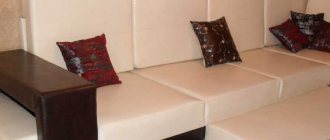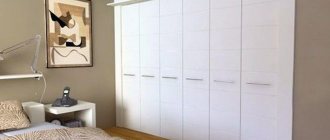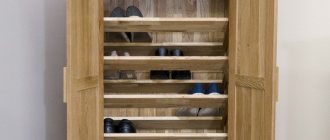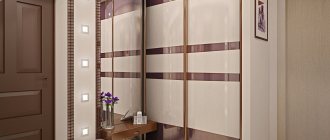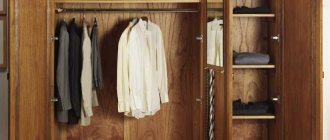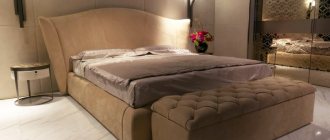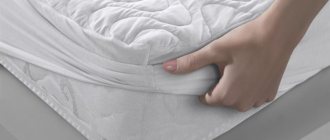Shoe rack - is it necessary?
In order not to clutter the hallway with a large number of shoes, you need to install a shoe rack. If relatives, acquaintances and friends often come to visit, having a shelf for storing shoes is a must.
With it, your hallway will be transformed into a stylish and comfortable calling card of your home.
Installing a shoe rack helps to maintain the cleanliness of the floor covering, maintain the required level of hygiene and increase health immunity. In addition, a properly made shoe rack can successfully transform the interior design of a hallway.
Shelves and drawers in the closet can be made to suit any type and size of shoes.
For convenience, the shoe rack is complemented with a soft seat on top. When you come home from work, you can sit down and carefully take off your shoes and put them on the shelf. The presence of such a piece of furniture for small apartments where there is little extra space is a must.
Such chests of drawers always look representative and elegant in the hallway, creating coziness and harmony in it.
VIDEO: DIY shoe cabinet.
Shoes are the passion of many women. How many pairs of shoes are needed for different occasions? Shoes for a business meeting, comfortable boots for walking, soft slippers. What then can we say when we are talking about a family where everyone needs boots or sneakers. Therefore, everyone faces the problem of storing it.
It is often difficult to install a spacious shelf in a small hallway. Shelves and cabinets simply do not fit into the dimensions of your narrow hallway.
In this case, you need to contact a custom-made furniture workshop. However, such services are more expensive than standard factory-produced solutions.
But the issue can be resolved differently. Make your own cabinet.
Shelves
The materials for making the cabinet can be chipboard and MDF, as well as plywood and natural wood.
It is necessary to take into account that plywood and wood are much more expensive than chipboards. But furniture made from these materials is more durable and, compared to chipboard, can withstand a humid environment better.
Chipboard and MDF boards, unlike wood, do not require additional processing.
The compressed structure of MDF makes the material quite durable. Working with this material is quite easy. Also consider its weight. We recommend using MDF only as a facade.
Chipboards have a wide color range. Therefore, it will be quite easy to fit the cabinet into the interior of the hallway.
As an additional decoration, you can order milling on the slab. This will make it unique.
DIY making
Before making a shoe rack with your own hands, drawings are drawn up. This is a must. It is important to correctly take all measurements in the hallway. After the drawings are drawn up, a material cutting diagram is compiled. This step is the most important, as your costs for boards, plywood, chipboard or other material will depend on it.
On the drawing you need to indicate the height, width and depth of the product.
But what materials can you use to assemble a shoe rack for the hallway with your own hands?
- Sheets of chipboard, MDF, plywood. The only disadvantage when choosing is the susceptibility of the sheets to moisture. Therefore, it is necessary to choose one with a protective plastic coating.
- Natural wood. Oak, ash, pine, birch and other species are well suited for manufacturing and layout. It is worth remembering that wood must be impregnated with special compounds to protect it from moisture, dirt, mechanical damage and other possible adverse factors.
- Metal. Making a metal shoe rack with your own hands presents minor difficulties in terms of applying paint and varnish. If you don’t have the skills to work with an inverter welding machine, then you won’t be able to carefully make a shelf. If you know how to cook, use the thinnest electrodes (2 mm) for welding and work carefully.
You can also use plastic. Ordinary water pipes, soldered at the right angle, will serve you for a long time as a place to store shoes.
This material is used to create various original items - armchairs, tables, shelves, etc.
DIY shoe rack - how to make a shoe rack, drawings
The Count of Monte Cristo had 12 pairs of shoes for all occasions. Sir Henry Baskerville made do with 2 pairs of shoes for the summer, half of one was also stolen. These days, 20 pairs of shoes per family is not uncommon, but an apartment or house is not Baskerville Hall or a fairy-tale palace. High-quality shoes are expensive, but budget shoes must last at least a season to justify themselves. In this regard, the idea of making a shoe rack with your own hands becomes especially relevant.
The very concept of “shoe rack” appeared relatively recently to designate a complex that provides orderly storage of out-of-season shoes and proper maintenance of shoes worn every day. As you know, the durability and wearability of shoes largely depends on the latter. However, restrictions on trade markups do not apply to accessories for wearable items, and for a simple shoe cabinet, which a craftsman can easily make with his own hands, traders want up to 5,000 rubles. and more, although retail materials for it can cost 1500-2000 or less. How? That's what this article is for.
Old simplicity
Drawings of a shelf for shoes made of plywood
The traditional, simplest and cheapest option for storing common shoes in the hallway is a 2-row floor shelf made of 6-10 mm plywood; for drawings see fig. on right. Shoes with high tops or berets (laced tops with tongues) are placed on the protruding part. This shoe rack is good for everyone, except for one thing: for 10 pairs you will have to give almost 0.5 square meters. m of usable area. And what’s worse, the width of 400 mm is the minimum possible for such a design. What if the entire hallway is 1.25 m wide? Therefore, the main trend in the design of modern shoe racks is compactness due to elongation and the use of simple mechanisms.
Note: depending on the availability of free space, a simple shoe rack can be made in other ways, see for example. track. video.
DIY shoe rack, making (video)
Now
The main module of a compact shoe rack is a cabinet for storing out-of-season shoes (item 1 in the photo) with compartments for shoes without high tops and with tops/tops. The first ones are usually made 3 (spring, summer, autumn), and one high, but those living outside the city need 4 low and 2 high compartments; “extra” for placing work shoes. They will not hurt in the city, for children's shoes.
Types of shoe racks
A shoe rack in the hallway is complemented, if there is enough space, with a bench or banquette for ease of putting on/taking off shoes. It is advisable to make openwork shelves under the seat for drying shoes (item 2), but in general it is better to dry shoes, especially for country residents, in a separate dryer, see below.
Drawings of a pouf for the hallway with accessories for shoe care
If there is very little space, you can get by with a pouf instead of a bench. A single owner can fit shoes out of season under his seat (item 3), but the conditions for storing them in this case are not entirely favorable. It is better to keep shoe care accessories in a pouf (see the drawing on the right), and place the supply of shoes in a separate organizer, see below. If the now unnecessary shoes are still in the pouffe, its drawer for ventilation should be equipped with holes in the bottom, and vents should be cut out under the seat.
The width of the pouffe seat and a regular bench is approx. 400 mm. In a narrow hallway with them there is less room for passage than ergonomics require, and even a hanger with clothes is right there. Therefore, the so-called petal shoe racks (item 4); shoes are stored in them in a vertical position on the shelves of folding trays, reinforced between the sector rotary sidewalls - petals. It is possible to make a petal-type shoe rack with a width of 250-260 mm: sitting down is enough, and in the hallway 1.25 m wide there is a passage of approx. 1 m, which is acceptable. In addition, the petal shoe rack provides good ventilation of the contents both with closed and open trays. And if you fold down the tray, the shoes dry in it better than on the shelves under the bench.
Due to their compactness and large capacity, petal shoe racks are often combined into monoblocks with other pieces of furniture for the hallway. A common option is a bedside table in the hallway with a shoe rack, pos. 5. With dimensions in plan (600-800) x (250-270) mm, it can accommodate the everyday shoes of a small family. If there is enough space (approx. 1.1 x 0.4 m in plan), the monoblock is supplemented with a seat (item 6).
Partitioning a round shoe shelf
If there is an unoccupied corner or niche in the hallway (which is not uncommon in old houses), then it is convenient to store shoes here in a carousel shoe rack, pos. 7. Dividing the contents into 4 seasons in the carousel shoe rack is achieved in the most natural way. To store winter shoes (boots, ankle boots), the shelves are partitioned asymmetrically, see fig. on right.
Note: A reasonably spacious hallway corner deserves more than shoe storage. For example, see another video - how to equip a corner closet with a shoe compartment in the hallway.
DIY wardrobe with shoe compartment (video)
Materials and connections
Shoe storage is best made from softwood or plywood . For maximum durability, dried shoes should be stored at room temperature and average (approx. 60-65%) humidity. But you can’t overdry shoes, especially budget ones made of leatherette; this often causes the uppers to crack. And over-drying will not benefit any other shoes, if only because the uppers with the markings of modern shoes are connected not with grit and nails, but with glue. Therefore, shoes are stored slightly damp. Porous wood will absorb excess water vapor, and if there is a lack of moisture in the air, it will release it. A wooden shoe rack is the only reliable option for storing everyday shoes if the box for them is blank, for example. in the pouf cabinet.
Properly dried shoes (see the end for more information on drying shoes and dryers for them) in a well-ventilated storage room can be stored immediately. In this case, the shoe rack can be made of laminated chipboard with a thickness of 12 mm; for the face you can order more expensive, but also more spectacular MDF. Laminated chipboard for shoe racks should be taken of medium grades after the expiration of phenol-containing compounds (E1 or E2). “Children’s” laminated chipboard of class E0 is expensive and fragile, and cheap lower classes E3 and E4 emit too much phenolic resin vapor. They are no less harmful to shoe leather, synthetics and glue than they are to you and me. For the same reason, OSB is not suitable for shoe racks - it is a building structural material that emits excess phenol during construction.
Note: only open, freely ventilated shoe racks are made of metal and plastic. The reason is that while laminated chipboard breathes at least a little in step with the shoes, metal and plastic do not breathe at all.
As for the connections of the shoe rack parts, they can be any kind of furniture: on dowels, confirmations, corners/overlays, tenons, miters, staples with a furniture stapler, etc. In general, assemble as you know how. For movable joints of petal shoe racks, see below.
How to make shoe racks
Petalaceae
Shoe racks with folding trays on petals are the most perfect, so let's start with them. The most seemingly complex (and expensive when purchasing a kit at retail) parts - the side petals - can be made with your own hands from sheet metal or hard plastic with a thickness of 4 mm or more. You can also cut the petals out of plywood with a thickness of 6 mm, then soak them twice with water-based acrylic varnish diluted in half. Impregnation is needed in this case to increase the rigidity of the part. The varnish is diluted with distilled (!) water.
Drawings of the petal shoe rack are shown in Fig. below. Each tray is 2-tier (spring-autumn and summer-house). For tall shoes you will have to add a locker, because... shoes with tops and ankle boots do not fit in the trays; This is perhaps the only drawback of petal shoe racks. The total height of one section H is taken from 300 mm. The upper and lower gaps between the tray cover and the front panel of the shoe rack are required to be at least 6 mm for ventilation. For the same purpose, the “sinus” pocket above the top tray should also be ventilated. To do this, a series of holes with a diameter of 40 mm or more are made at the top of the back wall of fiberboard or a gap is left. Ball locks or removable pins are installed in point A of the middle shelf (marked with a red arrow) so that the position of the middle shelf can be adjusted according to the contents.
Drawings of a shoe rack in the hallway
The design and dimensions of this type of trays for storing shoes in a wall niche with a depth of only 200 mm are given in the following. rice. The peculiarity of this design is that the sockets of the rotary hinges (see below) are made simply in the form of holes in brackets made of steel angles, mounted from the inside on the front trim of the niche. The tilting clamps are also attached to them, if it is far from the side walls of the niche. In this design, the front cover of the tray can be as high as desired, so this version of the petal shoe rack can also be made for tall shoes. One condition is that the front trim of the niche must be strong enough, not fragile. Drywall, for example, is not suitable in this case.
Setting up a shoe rack in a niche
Note: how to assemble a narrow shoe cabinet with your own hands, see the master class below.
DIY shoe cabinet (video)
Hinges and clamps
In petal, and some other shoe racks (see below) with hinged doors, there is another, at first glance, tricky assembly unit - a rotary hinge. There seems to be no way other than buying it, but you can still make it yourself. You only need pieces of thin-walled seamless tube, preferably brass - pieces of ballpoint pen bodies, elbow connectors of old spinning rods, etc. The cases of some types of Cuban cigars are excellent, but the prices for them now are not good for the night. And the actual procedure for making a homemade hinge for a folding shoe tray is as follows:
- We cut off parts from the tube with a length equal to the depth of the hinge socket. Usually - 1/2-2/3 of the thickness of the side wall of the shoe rack, but not less than 10 mm. The walls behind the nest should remain at least 5-6 mm. These will be socket clips, you need 2 of them for each hinge..
- Using a scraper (scraper, reamer), the same one used, say, when installing/dismantling air conditioner pipelines, we remove 0.25-0.35 mm chamfers from the inside of the clips.
- We select bolts for the holders with a round head of such a diameter that they fit into the holder with a gap of up to 0.5 mm. We remove burrs on the heads of the bolts (if the slot is straight) with a needle file. If necessary, you can use sandpaper to adjust the head to the holder.
- Use a Forstner drill to drill holes for the clips; It is advisable to take a drill of such a diameter (or select tubes for the clips) so that the clips fit tightly into the hole.
- We press the clips into the holes. If they fit freely, you can glue them with any metal mounting adhesive.
- We install the bolts accordingly. holes in the petals, tighten with nuts and spring washers - the hinges are ready for assembly.
Storage
It is preferable to store shoes that are not worn for a long time in a stable favorable microclimate (see above). Also, a cabinet or cabinet for out-of-season shoes in another room is necessary if there is not enough space in the hallway. In general, it is undesirable to keep shoes that have not been worn for a long time in the hallway, especially in a private house, where through the open front door you can smell cold or feel damp.
Rack and cabinet
Schemes of an open rack for long-term storage of shoes and a more compact shoe cabinet with hinged doors are shown in Fig. above and below respectively. The rack provides optimal conditions for long-term storage of up to 30 or more pairs of shoes, but requires approx. 0.6 sq. m area. With minimal ergonomics, this rack requires a dressing room of 6 square meters. m. The rack has no back wall; it is attached to the wall with steel corners and 6x70 self-tapping screws in plastic dowels. The material of the shelves and walls is board or chipboard 20 mm and timber 30x30 mm. Shelves, for better ventilation, made of steel mesh on wooden frames.
Schemes and drawings of racks and shelves for storing shoes
Note: this rack is universal. High and low sections can be added to it in width and height without restrictions, as long as there is enough space. Due to the distribution of fastenings, the wall behind the rack may be weak, e.g. a partition made of foam concrete or aerated concrete blocks.
The shoe cabinet is more compact and fits in a passage with a width of 1.5 m. The length of the cabinet is up to 2 m. The shelves are of the same design as in the previous one. case; They are attached to the sidewalls with dowels, corners, in milled grooves or on regular shelf holders. The back wall is ventilated, like a petal shoe rack (see above). An option with ventilation almost like a rack - a cabinet without a back wall with a gap between the cabinet and the wall of 40 mm (the width of the floor plinth). Then assembling the cabinet according to the diagram on the bottom right in Fig. The lining at the back is made from the same board as the shelves with partitions.
Organizers
But what to do if there is no space at all for a shoe closet? In this case, an organizer for long-term storage of shoes that are not currently worn will help out. True, in furniture stores you will most likely be offered a special shoe organizer closet (item 1 in the figure), which, with the doors open, will take up somewhere from 2 square meters. m. But in haberdashery and clothing stores you can find an incomparably cheaper shoe organizer-suitcase made of fabric, pos. 2, fits under the bed. In addition, shoes breathe freely in it.
Shoe organizers
But you don’t even need to buy a suitcase organizer if you have a sufficient number of shoe boxes. They are simply glued together, pos. 3. It is no more difficult for shoes to breathe in such an organizer, and it is easier to push it into the niche of the under-bed drawer. In this case, the soft organizer-suitcase often gets stuck.
A shoe organizer made of cardboard can also be glued together, for example. to the dacha, pos. 4. Designed with imagination, it can be completely in place in the apartment, if there is a suitable niche in the hallway, pos. 5. Then the cardboard shoe rack in the niche should be positioned in a spaced position so that the sides of the niche give rigidity to the entire product. For the same purpose, cardboard blanks are impregnated 2-3 times on both sides with a water-polymer emulsion or PVA diluted 2-3 times with water.
About drying and dryers
Wet shoes should be dried before storing them in a shoe rack or storage room. But – don’t buy electric shoe dryers for your home (see picture)! Their purpose is to quickly dry work shoes during business trips, field or expeditionary conditions, when you need to take over a shift or, say, go out for measurements minute by minute, and the cost of work shoes is included in advance in the estimate or current expenses.
Everyday shoes cannot be dried from the inside, otherwise even expensive branded products may crack the upper or peel off the sole before the warranty period expires. In such cases, experts in branded stores immediately determine that, sorry, the case is not covered by warranty. Here you go - a methodological guide with pictures. You dried them the way it is written here, right?
Everyday shoes should be dried either in a tilted toes-down position (pos. 1 in the figure below), or, better yet, hanging (but not by the laces or on the pins/toes!) pos. 2 and 3, or, even better, from the sole side, pos. 4. Stylish dryer-organizer for shoes, pos. 2 is technologically not that difficult if you know how to handle sheet plastics or stainless metals.
How to dry casual shoes
However, the most effective absorption dryer is pos. 4: completely wet boots dry in it in 2-4 hours at room temperature! As you know, the faster wet shoes dry without additional heating, the longer they last.
The secret of absorption shoe drying is in the stone backfill and accuracy: before you put the shoes on the dryer, you need to wash them. Crushed stone for an absorption dryer needs dolomite or other stone made of sufficiently durable and chemically low-active stone with greater moisture absorption. Activated carbon (not pharmaceutical tablets!) or silica gel drys shoes even faster, but drying them later is no easier than restoring the box of an old carbon gas mask. The best filling for an absorption shoe dryer is a sea shell or rounded sea pebbles. The service life of winter and work shoes, if they are kept on such backfill for the entire season, in addition to the time of use, almost doubles.
Tools
When choosing natural wood as a material, you will need the following tool:
- jigsaw;
- a circular saw;
- hand router;
- Sander;
- electric plane.
The process of processing boards is accompanied by the release of large amounts of dust and sawdust into the surrounding atmosphere. Therefore, be sure to use personal respiratory and vision protection, or forced dust removal mechanisms (cyclone, construction vacuum cleaner).
To work with chipboard, MDF or plywood, you will need the same tools as for wood.
In addition to electrical instruments, you need a ruler, tape measure, level, and marking pencil.
Pay attention to the selection of fasteners. This must be a specialized fastener. For wood - confirmations, self-tapping screws with rare threads. For chipboard - completely different fasteners.
After drawing up a drawing of the shoe rack, drawing all the dimensions, indicating communications, passages, as well as places for swing doors, a cutting diagram for the blanks is drawn up. All allowances of 1-2 mm must be indicated. This is necessary to leave a margin of length for the workpieces when sawing. The thickness of the saw blade is taken into account. You can find it out by measuring it with a ruler. Some manufacturers of consumables indicate the cutting thickness on the packaging.
The most suitable material for storing shoes is chipboard. Does not weigh down the shoe rack and is easy to assemble.
Build process
To work you will need:
- level;
- roulette;
- cordless screwdriver;
- screwdrivers;
- hammer.
When purchasing in a store, it is advisable to ask the seller if there are any special nuances during assembly. Such features can be expressed in the fastenings of hinges, locking elements (if any) and the propulsion system, if available. The entire assembly process is concluded in 4 points:
Shoe rack diagram.
When unpacking, you should be extremely careful and careful not to damage any of the parts (the box should also remain intact, because if there is a defect inside, it will serve as a guarantee that it was a factory defect). After unpacking, all parts are carefully checked for defects and recalculated. If possible, this process is carried out while the forwarder (delivery service) has not yet left the premises. This approach with witnesses on the part of the seller will completely secure the purchase in the event of a defect. Large pieces of furniture are assembled at home exclusively on the floor. If there is a carpet in the room, then it is better to roll it up, so as not to have to clean it again (and searching for small fittings in the carpet is very tedious). The process takes some time, so it is better to do it on the weekend or at sunset, when there is nothing else to do. You also need to pay attention to the presence of walls around, so as not to damage anything, and the floor is lined with cardboard or other dense material.
Shoe rack arrangement diagram.
A diagram is not required for assembly, even if it is available, because everything is always intuitive. During assembly, special chipboard screws are usually used, for which holes are made in advance (no self-respecting manufacturer will allow themselves to sell unprepared material). Using short nails, the back wall is fixed (sometimes also with screws). After everything is assembled, you need to cover the excess metal with plugs, which are also included in the kit. Using a level, everything is checked thoroughly. If irregularities are detected, then it is quite possible to remove the plug and tighten or align the required element.
Making a sliding shelf mechanism
When making a shoe shelf from sheet material, you can provide a folding shelf. This design is both functional and aesthetic. With its help, several compartments are mounted at once for storing boots, shoes and sneakers.
To simplify the work, you can order ready-made parts for the screed in the store. You need to decide where the shoe rack will stand.
The easiest way is to buy a ready-made structure. But independent installation is also possible. To do this, a pencil mark is made on the sidewall for a groove, which is drilled with an electric drill or selected with a router. Additionally, the groove is strengthened with an anti-friction bushing, which prevents deformation of the material under the influence of constant friction.
Closed models are aesthetically pleasing and are equipped with doors that serve as full protection for shoes.
Next, a spike is made on the folding shelf. It can be made from hard wood (oak, beech, hornbeam, ash). A hole of the appropriate diameter is drilled in the sidewall, into which a piece of hard wood is inserted. To strengthen it and prevent it from turning, it must be placed on a special adhesive.
DIY cardboard shelf
This is the most budget option for a shelf. And everything you need to make it can be found at home.
You will need:
- cardboard;
- ruler;
- pencil;
- PVA glue;
- scissors or carpenter's knife;
- stapler;
- scotch.
The most budget option when there are no necessary materials or money.
Lay a sheet of cardboard on the floor. We cut out rectangles measuring 45 by 30 cm from it. We form triangles 30 cm high from cardboard. This is one cell of our shoe rack. Let's connect them in a row. The edges must be sealed with tape to prevent the cardboard from tearing.
This is an excellent solution for country houses. The disadvantages of such a shelf are instability and low reliability. Therefore, it is better to put it in a niche.
You can also construct an organizer from thick paper or wood directly on the cabinet door.
Shoe rack on a cabinet door made of cardboard:
- cut out rectangles,
- roll them into a pocket,
- insert them into each other,
- attach to the cabinet door.
Shelf made of wooden planks:
- Attach a wooden strip to the cabinet door.
- Insert your sneakers, sandals or sneakers into the gap between the cabinet and the plank.
Open option. Quite convenient to use.
You can also make an open version of the product from wooden planks or boxes. In such a shelf the item will dry well. But it will also collect dust.
You can combine items and create a completely unique shoe rack that will not only collect all your shoes, but will also decorate your hallway. You can use the most ordinary objects for your own ideas: pipes, glass bottles
.
So, you see that there are many solutions for how to organize and store shoes even in the narrowest hallway. Decide what suits you best. Choose a shoe rack design with moving or static shelves.
No hallway can do without one of the many varieties of shoe racks
. This could be a place for temporary storage of outdoor shoes that have just been taken off, or it could be a huge pencil case, more like a mini-wardrobe, where all the pairs that the family is currently wearing can comfortably fit. The complexity of manufacturing is largely due to its configuration - the simpler the model suits you in terms of functionality, the easier and cheaper you will be able to manufacture it.
Assembling a shoe rack with a seat
To make a shoe rack with a seat for the hallway with your own hands, you must follow the assembly sequence.
The seat is made separately from the overall structure. You can use any suitable filler available at home as filling. Classic foam rubber is ideal. And if you have an old unnecessary orthopedic latex pillow or other filler, the choice of padding is simplified.
Hand-made furniture always distinguishes the interior from other apartments where there are typical chests of drawers and wardrobes.
The filler is placed on a sheet of plywood. Additionally, it can be glued. For beauty, tightening can be provided. To do this, you need to punch the foam rubber evenly over the entire area with a stapler. Next, a piece of fabric must be attached to each bracket, to which the top layer of the covering will subsequently be sewn.
For the perfect design, you can sew furniture buttons onto the seat.
The upholstery is cut only after the top cover has been made and the filling has been fastened.
The shoe rack is assembled in the following order.
- First, the side posts are connected to the intermediate shelves.
- Next, transverse jumpers are installed on the fasteners.
- Afterwards, a retractable shelf is installed (if available).
- At the end, the upper soft seat is attached.
Look at a selection of photographs of shoe shelves. Here you will definitely find something for yourself.



